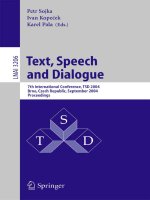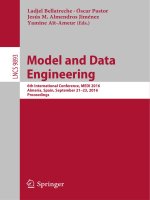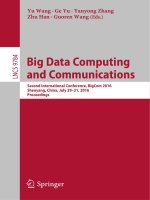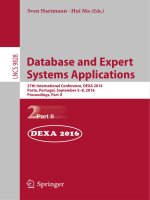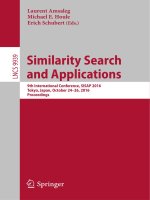Knowledge engineering and semantic web 7th international conference, KESW 2016
Bạn đang xem bản rút gọn của tài liệu. Xem và tải ngay bản đầy đủ của tài liệu tại đây (25.24 MB, 367 trang )
Axel-Cyrille Ngonga Ngomo
Petr Křemen (Eds.)
Communications in Computer and Information Science
649
Knowledge Engineering
and Semantic Web
7th International Conference, KESW 2016
Prague, Czech Republic, September 21–23, 2016
Proceedings
123
Communications
in Computer and Information Science
649
Commenced Publication in 2007
Founding and Former Series Editors:
Alfredo Cuzzocrea, Dominik Ślęzak, and Xiaokang Yang
Editorial Board
Simone Diniz Junqueira Barbosa
Pontifical Catholic University of Rio de Janeiro (PUC-Rio),
Rio de Janeiro, Brazil
Phoebe Chen
La Trobe University, Melbourne, Australia
Xiaoyong Du
Renmin University of China, Beijing, China
Joaquim Filipe
Polytechnic Institute of Setúbal, Setúbal, Portugal
Orhun Kara
TÜBİTAK BİLGEM and Middle East Technical University, Ankara, Turkey
Igor Kotenko
St. Petersburg Institute for Informatics and Automation of the Russian
Academy of Sciences, St. Petersburg, Russia
Ting Liu
Harbin Institute of Technology (HIT), Harbin, China
Krishna M. Sivalingam
Indian Institute of Technology Madras, Chennai, India
Takashi Washio
Osaka University, Osaka, Japan
More information about this series at />
Axel-Cyrille Ngonga Ngomo Petr Křemen (Eds.)
•
Knowledge Engineering
and Semantic Web
7th International Conference, KESW 2016
Prague, Czech Republic, September 21–23, 2016
Proceedings
123
Editors
Axel-Cyrille Ngonga Ngomo
Leipzig University
Leipzig
Germany
Petr Křemen
Czech Technical University in Prague
Prague
Czech Republic
ISSN 1865-0929
ISSN 1865-0937 (electronic)
Communications in Computer and Information Science
ISBN 978-3-319-45879-3
ISBN 978-3-319-45880-9 (eBook)
DOI 10.1007/978-3-319-45880-9
Library of Congress Control Number: 2016949634
© Springer International Publishing Switzerland 2016
This work is subject to copyright. All rights are reserved by the Publisher, whether the whole or part of the
material is concerned, specifically the rights of translation, reprinting, reuse of illustrations, recitation,
broadcasting, reproduction on microfilms or in any other physical way, and transmission or information
storage and retrieval, electronic adaptation, computer software, or by similar or dissimilar methodology now
known or hereafter developed.
The use of general descriptive names, registered names, trademarks, service marks, etc. in this publication
does not imply, even in the absence of a specific statement, that such names are exempt from the relevant
protective laws and regulations and therefore free for general use.
The publisher, the authors and the editors are safe to assume that the advice and information in this book are
believed to be true and accurate at the date of publication. Neither the publisher nor the authors or the editors
give a warranty, express or implied, with respect to the material contained herein or for any errors or
omissions that may have been made.
Printed on acid-free paper
This Springer imprint is published by Springer Nature
The registered company is Springer International Publishing AG Switzerland
Preface
These proceedings contain the papers accepted for oral presentation at the 7th International Conference on Knowledge Engineering and Semantic Web (KESW 2016).
The conference was held in Prague, Czech Republic, during September 21–23, 2016.
The principal mission of the KESW conference series is to provide a discussion
forum for the community of researchers currently underrepresented at the major
International Semantic Web Conference (ISWC) and Extended Semantic Web Conference (ESWC). This mostly includes researchers from Eastern and Northern Europe,
Russia, and former Soviet republics. This year, the conference was held in Prague to
catalyze discussions between the traditional KESW community and the European
research community.
As in previous years, KESW 2016 aimed at helping the community to get used to
the common international standards for academic conferences in computer science. To
this end, KESW featured a peer reviewing process in which every paper was reviewed
in a rigorous but constructive way by at least three members of the Program Committee. As before, the PC was international, representing countries ranging from the
USA to Japan and Germany.
We received a total of 53 submissions. The strict reviewing policies have resulted in
the acceptance of 17 full research papers. This translates into an acceptance rate of
32 %. Additional 9 papers (17 %) were accepted for short presentation and have also
been given space in these proceedings. The authors represent mainly EU countries,
including Germany, Spain, and the Czech Republic as well as various parts of Russia.
KESW 2016 continued the tradition of inviting established researches for keynote
presentations. We are grateful to Lynda Hardman (CWI, Netherlands), Axel Polleres
(WU Vienna, Austria), Steffen Staab (University of Koblenz, Germany), and Filip
Železný (FEE CTU, Czech Republic) for their insightful talks. The program also
included posters and position paper presentations to help attendees, especially younger
researchers, discuss preliminary ideas and promising PhD topics.
We thank Dmitry Mouromtsev and Pavel Klinov, who helped us immensely during
conference preparation. Next, we would like to thank both organizing institutions,
Czech Technical University in Prague and ITMO University, for their support. Next,
we would like to express our thanks to this year’s sponsors, namely Datlowe, s.r.o., STI
Innsbruck, and metaphacts GmbH – without their support the event would hardly be
possible. We would also like to thank the hardworking PC as well as our publicity
chairs, Martin Ledvinka and Maxim Kolchin, for their reliable and quick work. Last but
not least, we would like to thank the Action M Agency, particularly Milena
Zeithamlová, for their reliable administrative support.
July 2016
Petr Křemen
Axel-Cyrille Ngonga Ngomo
Organizing Committee
General Chair
Petr Křemen
FEE CTU in Prague, Czech Republic
Program Chair
Axel-Cyrille Ngonga
Ngomo
Institute for Applied Informatics, Germany
Publicity Chairs
Martin Ledvinka
Maxim Kolchin
FEE CTU in Prague, Czech Republic
ITMO University, Russia
Program Committee
Alessandro Adamou
Long Cheng
Evangelia Daskalaki
Jeremy Debattista
Chiara Del Vescovo
Elena Demidova
Ivan Ermilov
Irini Fundulaki
Ujwal Gadiraju
Kleanthi Georgala
Peter Haase
Ali Hasnain
Martin Homola
Konrad Hưffner
Dmitry Ignatov
Vladimir Ivanov
Valentina Ivanova
Natalya Keberle
Evgeny Kharlamov
Jakub Klímek
Pavel Klinov
Boris Konev
KMI, The Open University, UK
Technische Universität Dresden, Germany
ICS-FORTH, Greece
University of Bonn, Germany
British Broadcasting Corporation, UK
University of Southampton, UK
Universität Leipzig, Germany
ICS-FORTH, Greece
L3S Research Center, Germany
Universität Leipzig, Germany
metaphacts GmbH, Germany
Digital Enterprise Research Institute, Ireland
Comenius University Bratislava, Slovakia
Universität Leipzig, Germany
National Research University Higher School
of Economics, Russia
Kazan Federal University, Russia
Linköping University, Sweden
Zaporizhzhya National University, Ukraine
University of Oxford, UK
FIT CTU in Prague, Czech Republic
Complexible Inc., USA
University of Liverpool, UK
VIII
Organizing Committee
Roman Kontchakov
Birkbeck
Liubov Kovriguina
Dmitry Kudryavtsev
Christoph Lange
Steffen Lohmann
Nicolas Matentzoglu
Dmitry Mouromtsev
Elena Mozzherina
Rafael Pealoza
Denis Ponomaryov
Héctor Pérez-Urbina
Mariano Rodríguez Muro
Yuliya Rubtsova
Muhammad Saleem
Tzanina Saveta
Marvin Schiller
Daria Stepanova
Lauren Stuart
Julia Taylor
Ioan Toma
Dmitry Tsarkov
Joerg Unbehauen
Dmitry Ustalov
Amrapali Zaveri
Dmitriy Zheleznyakov
University of London, UK
NRU ITMO, Russia
Saint Petersburg State Polytechnical University, Russia
University of Bonn, Germany
Fraunhofer IAIS, Germany
University of Manchester, UK
NRU ITMO, Russia
Saint Petersburg State University, Russia
Free University of Bozen-Bolzano, Italy
A.P. Ershov Institute of Informatics Systems, Russia
Google, USA
IBM Research, USA
A.P. Ershov Institute of Informatics Systems, Russia
Universität Leizpig, Germany
ICS-FORTH, Greece
Universität Ulm, Germany
Technical University of Vienna, Austria
Purdue University, USA
Purdue University, USA
STI Innsbruck, Austria
The University of Manchester, UK
Universität Leipzig, Germany
Ural Federal University, Russia
Stanford University, USA
University of Oxford, UK
Additional Reviewers
Callahan, Alison
Del Corro, Luciano
Déraspe, Maxime
Gossen, Gerhard
Gottschalk, Simon
Grangel, Irlan
Kozlov, Artem
Siu, Amy
Uhliarik, Ivor
Vahdati, Sahar
Zhukova, Nataly
Organizing Committee
Organizers
CTU in Prague
ITMO University
Sponsors
Datlowe
Metaphacts
STI Innsbruck
IX
Contents
Ontologies
Multi-viewpoint Ontologies for Decision-Making Support . . . . . . . . . . . . . .
Sergey Gorshkov, Stanislav Kralin, and Maxim Miroshnichenko
3
Ontological Anti-patterns in Aviation Safety Event Models . . . . . . . . . . . . .
Jana Ahmad and Petr Křemen
18
User-Driven Ontology Population from Linked Data Sources . . . . . . . . . . . .
Panagiotis Mitzias, Marina Riga, Efstratios Kontopoulos,
Thanos G. Stavropoulos, Stelios Andreadis, Georgios Meditskos,
and Ioannis Kompatsiaris
31
Ontology for Performance Control in Service-Oriented System
with Composite Services . . . . . . . . . . . . . . . . . . . . . . . . . . . . . . . . . . . . .
Maksim Khegai, Dmitrii Zubok, Tatiana Kharchenko,
and Alexandr Maiatin
42
Privacy in Online Social Networks: An Ontological Model
for Self-Presentation . . . . . . . . . . . . . . . . . . . . . . . . . . . . . . . . . . . . . . . .
Javed Ahmed
56
Design of an Ontologies for the Exchange of Software Engineering Data
in the Aerospace Industry. . . . . . . . . . . . . . . . . . . . . . . . . . . . . . . . . . . . .
Ricardo Eito-Brun
71
Information and Knowledge Extraction
Family Matters: Company Relations Extraction from Wikipedia . . . . . . . . . .
Artem Kuznetsov, Pavel Braslavski, and Vladimir Ivanov
A Bank Information Extraction System Based on Named Entity
Recognition with CRFs from Noisy Customer Order Texts in Turkish . . . . . .
Erdem Emekligil, Secil Arslan, and Onur Agin
A New Operationalization of Contrastive Term Extraction Approach Based
on Recognition of Both Representative and Specific Terms . . . . . . . . . . . . .
Aliya Nugumanova, Igor Bessmertny, Yerzhan Baiburin,
and Madina Mansurova
Ontology-Based Information Extraction for Populating the Intelligent
Scientific Internet Resources. . . . . . . . . . . . . . . . . . . . . . . . . . . . . . . . . . .
Irina R. Akhmadeeva, Yury A. Zagorulko, and Dmitry I. Mouromtsev
81
93
103
119
XII
Contents
Thesaurus-Based Method of Increasing Text-via-Keyphrase Graph
Connectivity During Keyphrase Extraction for e-Tourism Applications . . . . .
Ilya Paramonov, Ksenia Lagutina, Eldar Mamedov,
and Nadezhda Lagutina
Identifying Product Failures from Reviews in Noisy Data
by Distant Supervision. . . . . . . . . . . . . . . . . . . . . . . . . . . . . . . . . . . . . . .
Elena Tutubalina
Elicitation Taxonomy for Acquiring Biodiversity Knowledge . . . . . . . . . . . .
Andréa Corrêa Flôres Albuquerque, José Laurindo Campos dos Santos,
and Alberto Nogueira de Castro Júnior
Semantic Knowledge Base: Quantifiers and Multiplicity in Extended
Semantic Networks Module . . . . . . . . . . . . . . . . . . . . . . . . . . . . . . . . . . .
Marek Krótkiewicz, Krystian Wojtkiewicz, Marcin Jodłowiec,
and Waldemar Pokuta
129
142
157
173
Data Management
RDF Query and Inference in Prolog . . . . . . . . . . . . . . . . . . . . . . . . . . . . .
M.B. Alves, C.V. Damásio, and N. Correia
191
An Approach for Structuring Sound Sample Libraries Using Ontology . . . . .
Eugene Cherny, Johan Lilius, Johannes Brusila, Dmitry Mouromtsev,
and Gleb Rogozinsky
202
Efficient SPARQL to SQL Translation with User Defined Mapping . . . . . . .
Miloš Chaloupka and Martin Nečaský
215
Comparison of Different Approaches for Hotels Deduplication . . . . . . . . . . .
Ivan Kozhevnikov and Vladimir Gorovoy
230
Fostering Accessibility of OpenCourseWare with Semantic
Technologies – A Literature Review . . . . . . . . . . . . . . . . . . . . . . . . . . . . .
Mirette Elias, Steffen Lohmann, and Sören Auer
Nearest Query on Distributed Binary Trees Starting from a Random Node . . .
Francesco Gargiulo, Flora Amato, Vincenzo Moscato,
Antonio Picariello, and Giancarlo Sperli’
Ethnicity Sensitive Author Disambiguation Using Semi-supervised
Learning . . . . . . . . . . . . . . . . . . . . . . . . . . . . . . . . . . . . . . . . . . . . . . . .
Gilles Louppe, Hussein T. Al-Natsheh, Mateusz Susik,
and Eamonn James Maguire
Towards Flexible K-Anonymity . . . . . . . . . . . . . . . . . . . . . . . . . . . . . . . .
Rima Kilany, Maria Sokhn, Hussein Hellani, and Shaban Shabani
241
257
272
288
Contents
XIII
Applications
Ontology-Based Collaborative Development of Domain Information Space
for Learning and Scientific Research . . . . . . . . . . . . . . . . . . . . . . . . . . . . .
Anton Anikin, Dmitry Litovkin, Marina Kultsova, and Elena Sarkisova
301
Challenges of Implementation and Practical Deployment of Aviation Safety
Knowledge Management Software . . . . . . . . . . . . . . . . . . . . . . . . . . . . . .
Peter Vittek, Andrej Lališ, Slobodan Stojić, and Vladimír Plos
316
Requirements to Modern Semantic Search Engine . . . . . . . . . . . . . . . . . . . .
Ricardo Usbeck, Michael Röder, Peter Haase, Artem Kozlov,
Muhammad Saleem, and Axel-Cyrille Ngonga Ngomo
Medical Knowledge Representation for Evaluation of Patient’s State
Using Complex Indicators . . . . . . . . . . . . . . . . . . . . . . . . . . . . . . . . . . . .
Mikhail Lushnov, Vyacheslav Kudashov, Alexander Vodyaho,
Maxim Lapaev, Nataly Zhukova, and Denis Korobov
Author Index . . . . . . . . . . . . . . . . . . . . . . . . . . . . . . . . . . . . . . . . . . . .
328
344
361
Ontologies
Multi-viewpoint Ontologies
for Decision-Making Support
Sergey Gorshkov1(&), Stanislav Kralin2,
and Maxim Miroshnichenko1
1
TriniData, Mashinnaya 40-21, 620089 Ekaterinburg, Russia
{serge,miroshnichenko}@trinidata.ru
2
Ekaterinburg, Russia
Abstract. Considering multiple viewpoints is often required when building
ontologies for decision-making support systems. The notion of subjective context
is useful for designing such a systems. We review the evolution of the subjectivity
representation in the knowledge engineering, then choose an appropriate definition
of the context for our application. This allows formulating the functional requirements for a multi-viewpoint decision-making support system and choosing the
technical way of context representation. We propose a method of ontological
representation of multiple viewpoints using named graphs as a response to these
requirements. Decision-making support in the socio-economic realms is an especially valuable application for multi-viewpoint ontologies. We consider a
demonstration use case, including software implementation. The inference rules
may be used in such applications both for making conclusions within every particular context, or transferring knowledge between them. We present a set of
sample rules for our demonstration use case and discuss the results achieved.
Keywords: Multi-viewpoint ontology
modeling
Á
Decision making support
Á
Context
1 Introduction
It is often necessary to reflect different standpoints concerning the same objects and
operation when using Semantic Web technologies for building decision-making support systems.
The development of a software application usually includes implicit construction of
the uniform model for a fragment of reality. This model reflects only one view of it, or
combines several views cleared of contradictions. Meanwhile every process in the
socio-economic realm includes a number of independent subjects. Each of them possess a unique set of opinions. Sometimes it is possible to neglect this diversity, but
tasks of the other classes require their careful consideration. Among the examples of
S. Kralin––Independent researcher.
© Springer International Publishing Switzerland 2016
A.-C. Ngonga Ngomo and P. Křemen (Eds.): KESW 2016, CCIS 649, pp. 3–17, 2016.
DOI: 10.1007/978-3-319-45880-9_1
4
S. Gorshkov et al.
such tasks are the socio-economic systems management, administration of legislation,
management of the complex projects performed by the groups of contractors.
In this work, we will choose the way of representation of multiple viewpoints in
ontologies using available functionality of OWL and SPARQL, implementation of the
inference on these models, and verification of the practical applicability of the results
achieved. For the last task, we will consider a demonstration prototype of the
decision-making support system. The practical goal of this prototype is the assistance
in political decisions making by representing opinions of various social groups on the
different variants of the possible developments of situation, reproduction of the way of
thinking of the people in these groups. The analysis of this information allows
revealing the possible influence of the decisions on the citizen’s attitude, helps balance
all the interests, and shows a set of possible ways of leveling negative effects of
unpopular actions.
On the side, we have split this article into several blocks reflecting viewpoints of
the demonstration system’s end-user, ontologist/analyst formalizing the task and
building a model for it, and the programmer implementing the solution. Each block
starts with the wording like “From the analyst’s point of view”. We hope this will
structure our text, show the benefits of considering multiple viewpoints even at the
meta-level of modeling and software engineering, and demonstrate how the different
people are seeing the same things.
2 Related Works
From the analyst’s point of view, the description logic lying in the base of the
simplest OWL variants does not offer some features, which may be found in the more
common logic. It is designed for the ease of determining truthfulness of the statements
(and provides decidability and low computation complexity), but does not offer tools
for working with the “truth-value gluts”, particularly rooted in the distinction of the
judgements of different subjects. Such situations are common in our life; however, the
relativity of truth is generally counterintuitive for the human way of thinking, and our
mind tends to search for the “absolute truth” it presume to exist even in purely subjective debates. The ontologists also may be misled in this way, which makes it harder
to grasp and model the multi-subject situations.
There are two strategies of dealing with “truth-value gluts” in common logic:
integrating and isolating ones. The examples of the integrating strategy are the paraconsistent and non-monotonic logical systems. There are also the extralogical frameworks which may serve for this purpose, such as Dung’s one [9]. However, we do not
have a task of direct resolution of contradictions; we want to assert them and to model
how these contradictory judgements are producing different conclusions in various
subjective contexts.
The examples of the isolating strategy are the multi-modal epistemic and doxastic
logics going back to Hintikka [10], and McCarthy’s notion of context formulated with
the first-order tools [15]. Both multi-modal and first-order approaches cannot be
directly translated into description logic. The tools of the first-order approaches lie
beyond the limits of the guarded fragment, which contains description logics [1, 20].
Multi-viewpoint Ontologies for Decision-Making Support
5
The modal approaches transform the description logic, which is a multi-modal system
by its nature, into the many-dimensional modal system [14], which leads to the rise of
computational complexity or even undecidability.
Actually, there are some contextual [12], epistemic [2] and even paraconsistent
description logics of limited expressivity, which are rather far from implementation in
OWL, although their features are considered important for using with description logics
as a modeling language [2].
An overview of multi-modal, first-order and other approaches to the subjectivity
modeling was given by Sowa [21]. We are not considering there the attempts of
modeling subjectivity directly in semantics, and more or less technical semantics
allowing “relativistic” interpretations, such as Kripke’s possible worlds [13],
Hintikka’s model sets [11], and Barwise and Perry’s situations [3].
Among the reviewed approaches, J. McCarthy’ notion of a context [21] is important
for us as a starting point for our implementation. A context is a just one version of the
reality description. This definition is important for us, as it implies existence of several
descriptions of the same fragment of reality, which may be contradictory and equally
authoritative. Some of the further developers of this theory has emphasized, for
example, the linkage of a context with a subject or a group of subjects sharing it [19].
Montague has shown that it is necessary to consider the points of reference for
establishing truthfulness of the statements. A set of meaningful objects is distinguished
for each point of reference, and the value (intension) and extension of each predicate is
defined [16]. We will solve our task basing on this approach.
The context’s content in our implementation is a usual OWL model. We build a
meta-level over this model, describing the relations of the subjects and contexts, and
methods of their interaction. These methods may also include the rules of “translation”
from one contextual “language” to another.
From the programmer’s point of view, even the OWL Full standard does not
offer an explicit method for creating meta-models described above. The researchers
facing necessity of reflecting several viewpoints in ontology are finding their own ways
to do this. For example, A. Boer, considering the ontological representation of legislative information, has introduced the notion of subjective betterness, which is used
for selection of appropriate positions of regulation [4]. The betterness is an OWL
relation, defined for the pairs of situations considered by a legislator. Situations are
represented as OWL individuals. The LKIF ontology, designed with participation of A.
Boer, is representing the concepts like “believes”, “states” as OWL relations. The
authors are proposing the mode of modalities representations, which does not break the
OWL limits, avoids emergence of extra objects, but has a limited expressiveness.
The common method for modalities formalization is the reification. It implies the
generation of the special entities for each statement, belonging to the classes like
“Belief” [19]. These entities are linking subjects and the opinions. Let us consider an
example: “John believes that Penguins are living in Arctic”. We have to create an
individual #John_sBelief (see Fig. 1) belonging to the class #Belief, which has relation
#hasBearer (all identifiers are arbitrary and given just for readability) with the individual #John, and relation #hasBelievedFact with the individual #ArcticPenguins. The
#ArcticPenguins, in turn, is an instance of the class #AnimalArea, having relation
#hasSpecies with the #Penguins and relation #hasArea with the region #Arctic
6
S. Gorshkov et al.
Fig. 1. One of the ways of representing beliefs in ontology
(of course, other structures for expressing this fact are also possible). This method also
allows remaining within the limits of the OWL standard. It has its own opportunities
and drawbacks, among which is the creation of “extra” entities such as #John_sBelief.
On the side, let us note that someone may argue that it is not necessary to represent
false assertions (such as “Penguins are living in Arctic”) in ontologies. There are two
reasons to do that: (a) many assertions cannot be surely proved or refuted at all,
(b) sometimes pragmatics dictates to do that. Imagine John is your boss and discussion
about penguins may cost you too much.
The C-OWL is an extension of OWL, which allows description of the rules of
reference between different ontologies elements. Each of these ontologies is representing a specific context [5]. C-OWL solves the task of knowledge transformation
between different subjective contexts, “translation” from one language to another, but
does not explicitly defines the subjects, context owners. It does not allow representation
of contradictory opinions on the same situations expressed in the same terms by the
different subjects, does not provide the ability to distinguish logical rules they use.
P-SOC-OWL ontology extends C-OWL ideas, resolving some of these problems, and
introducing means for representing subjective opinions on the same objects [17]. This
ontology even allows expressing the confidence degree of the subject in some statement.
Djakhdjakha et al. are offering a rather mature approach to the same task in [7] and
the following series of papers. The authors are considering multi-viewpoint ontologies
using the notions of a global and local context, global and local role, individual,
subsumption rules and bridge rules. This approach implements means of expressing
alignments and contradictions between points of view. Some particular questions are
well developed, such as classification of individuals from different points of view [8].
Let us note that the prevailing approach to the contexts formalization in OWL is the
segregation of each context into a separate ontology, and linking them with various
means. This way is not the only possible. An OWL ontology may be considered as a
theory of some subject matter area, with several points of view built in [18]. We will
design our implementation basing on the idea of using named graphs for context
representation [6].
Multi-viewpoint Ontologies for Decision-Making Support
7
3 Motivation
From the analyst’s point of view, the modeled system often shall be regarded in a
number of points of view, each one matching some subject or group. Our task is to
propose a method of implementation of the next functional requirements using OWL
standard features:
1. To provide ability of description of subjects or their groups in a model, and their
distinct points of view (contexts).
2. Each viewpoint may contain its special terms (notions) for expressing some concepts (ideas), which may be shared between viewpoints, or be specific for some of
them.
3. In each viewpoint, a distinct set of facts about some individuals may be expressed.
If the individuals are shared between contexts, some facts on them may be contradictory. The important special case is the representation of different regards on
the composition of some object.
4. Each viewpoint may contain its own user-defined inference rules.
5. Arbitrary rules of knowledge transformation between viewpoints may be defined, as
well as the rules for synthesis of knowledge from different viewpoints. The special
case is the situation when some notions from different viewpoints are referring to
the same concept. Then it is necessary to define rules of “translation from one
conceptual language to another”.
From the programmer’s point of view, we have to meet the following technical
requirements:
1. The whole model shall be stored in a single ontology.
2. We shall avoid reification (introduction of the extra individuals expressing things
such as “[someone] has opinion”).
3. We shall provide a method for accessing particular viewpoints as well as the whole
ontology through a SPARQL endpoint.
From the end user’s point of view, we need a sample use case, for which the listed
requirements are actual. Let us consider a hypothetical decision-making support software, which is used by the top executive of some municipality. As it is an elective
office, the politician wants to know how some variants of his or her actions will affect
the public opinion. Imagine that some company wants to obtain permission for construction of the industrial facility in the city. In our simplified example, let us consider
three point of view on this question:
– Of the citizens aware of economy problems: for them, a new facility is a source of
workplaces.
– Of the citizens aware of ecology problems: for them, a new facility is a source of
pollution.
– Of the state and municipal employee: for them, a new facility is just an object,
which is classified by regulations and which shall be compliant with its
requirements.
8
S. Gorshkov et al.
We shall consider the city’s top official as the person who is able to switch between
various points of view to make the most pragmatic decision. In our sample use case, the
politician wants to have an IT system, which will model the way of thinking of the
people of the various social groups, predict their reaction on the approval or denial of
the facility construction, and estimate parameters of the affected interests.
4 Implementation
From the analyst’s point of view, our conceptual model will have the next structure.
First, there are subjects and groups of them, having their points of view. Each subject or
group has its own interests, which may be fulfilled or ignored as a result of the political
decisions. Collective subjects has their own metrics, which can be measured in sociological surveys: amount of people involved, distribution of subjective perception of
the importance of the interest within group etc.
Let us consider classification of the individual object representing the planned
facility (we will name it “Acme Manufacturing”) in various viewpoints. This will
illustrate implementation of functional requirement #2 from the above list (Table 1).
Table 1. Classification of the acme manufacturing individual
Citizens (ecology)
Industrial facility
Source of pollution
Citizens (economy)
Industrial facility
Source of workplaces
State employee
Object of technical regulation
Source of pollution; object of ecological
regulation
Source of workplaces; object of fiscal
regulation
Figure 2 shows how the relations of various classes and properties with the different viewpoints reflects the perception of the situation by the subjects.
Thereby, various points of view may use different notions (terms) for denotation of
the same (or mismatching) concepts and individuals.
Different subjects are viewing an object’s structure differently. For example, for the
ecology-aware citizens it is important that the facility include the boiler working on the
hydrocarbon fuel. State employee are viewing object’s structure in a much more
complex way. The schema of the ontology fragment representing this situation is
shown on the Fig. 3. This is how we implement functional requirement #3 from the
above list.
Various subjects are making inference using different rules. For example, for the
citizens the valid rule is “An industrial facility is a source of pollution, if it includes a
hydrocarbon-powered boiler”. In the same time, for the state employee, who are using
regulations as a source of inference, the valid rule may sound like “An industrial
facility is a source of pollution, if it emits a dangerous substance X in the concentration
Y”. The both rules are assigning the same class name (“source of pollution”), but the
conditions when it is applicable are different. What is a source of pollution for one
Multi-viewpoint Ontologies for Decision-Making Support
9
Fig. 2. Classification and properties of the object in different viewpoints
Fig. 3. Decomposition of the object in different viewpoints
subject is not necessary a source of pollution for another, and both of them have their
reasons. Therefore, we have implemented the functional requirement #4.
We will follow the next way of implementations:
– Describe the subjects and their interests in the model.
– Describe the individual object (facility), common for all the viewpoints (although
the subjects are seeing it differently).
– Formulate the rules of inference for various viewpoints, reflecting the way of
thinking of the people of various social groups.
– Represent the possible variants of the management decisions. The rules are formulated according to the social group’s opinions analysis, and are allowing to infer
how each decision affects the interests of the subjects.
– The system’s end user, a politician, can explore the variants of management decision, and see which interests are violated in each case, and by which reason.
10
S. Gorshkov et al.
The Fig. 4 shows overall ontology structure:
Fig. 4. Ontology structure for the use case
This diagram tells that every subject may possess some interest(s), which may be
satisfied of violated by some decisions. Every decision is either an approval or a denial
of a specific action over some object. Of course, this ontology is very sketchy; in the
real use, the model shall look much more complicated.
From the programmer’s point of view, the implementation will include a
SPARQL endpoint, in which the above listed information will be stored. The following
software components will work with it: an inference engine, an ontology editor, and a
user interface for model exploration (Knowledge Management System, KMS).
We represent subjects or the groups of them as the individuals belonging to the
class #Subject. All the content of the endpoint is split onto named graphs, each of them
representing a particular point of view. One of the graphs represents a “consensus” (or
“common”) point of view, containing the facts that are true for all the subjects considered. The other facts are distributed between the named graphs according to the
viewpoints in which they are asserted.
For example, we have the individual #EcologyCitizens representing the group of
subjects (and thus belonging to the class #Subject), and the #PublicOfficials individual.
The next triples represent the fact that ecology-aware citizens consider Acme Manufacturing as a source of pollution, while public officials are treating it as just an object
of ecological regulation. Both parties agree that it is an industrial facility (Table 2):
Table 2. Triples representing classification of the #AcmeMfg individual
RDF triple
Entity (“subject”)
#AcmeMfg
#AcmeMfg
#AcmeMfg
Predicate
rdf:type
rdf:type
rdf:type
Graph
Object
#PollutionSource
#EcologyCitizens
#EcoRegulationObject #PublicOfficials
#IndustrialFacility
We see that the name of the graph matches the identifier of the group of subjects
possessing the point of view, or it is empty (or has some default value) for the
“consensus” one. Our engine expects to find the graphs named after the designated
subjects. When we need to obtain information valid for particular point of view, our
engine rewrites SPARQL query using graph name(s). The engine functions below the
application layer of the system. For example, user opens #AcmeMfg individual, and the
application has to display the list of classes to which it belongs. The application issues a
simple query like:
Multi-viewpoint Ontologies for Decision-Making Support
11
SELECT ?type WHERE {#AcmeMfg rdf:type ?type }
The engine seamlessly rewrites it into a more complicated query:
SELECT ?type ?graph WHERE {GRAPH ?graph {#AcmeMfg rdf:type ?
type } }
The engine filters the result upon receiving. For example, it will retain only the
triples from #EcologyCitizens or default graph, if the chosen viewpoint is #EcologyCitizens. As an alternative, graph name may be explicitly specified in the query.
Our ontology editor (Onto.pro) is working by the same way, assigning entered
assertions to the chosen point(s) of view.
This approach is more convenient than, for example, using OWL annotations for
assigning facts to the viewpoints. It is more laconic, allows specifying easily the point
of view in SPARQL queries and/or filter query results according to the points of view,
and even combining data from different viewpoints in a single query (in this case query
rewriting becomes a little more complicated, but still can be handled automatically). By
the same reasons, it is more convenient than separating various viewpoints onto different ontologies. Less changes in SPARQL queries (or no changes at all, for the
front-end application) comparing to the single viewpoint ontologies means better
performance and flexibility. In addition, it isolates the application layer from the
viewpoints implementation when needed.
In the model exploration interface (we use our software ArchiGraph.KMS for this)
we provide ability of choosing point of view of some subject. After that, the user sees
only the facts that are valid for the chosen viewpoint and/or the “consensus” one. The
software filters the information according to the named graphs to which it belongs to
achieve this.
Let us show some examples of inference rules used in our sample case (Table 3).
The last rule illustrates fulfillment of the functional requirement #5 of our list.
In our implementation, we use the SPARQL rules tagged by the appropriate
viewpoint(s) in their metadata. Our engine follows the idea of SPIN rules, but has the
original implementation, which adds some extra features to them. Each triple emerged
as a result of the rule is annotated with the reference to the rule which has produced it.
5 Use Case Demonstration
From the analyst’s point of view, work with the system include the next steps:
1. Create the model structure and fill it with the initial fact information. In our case, it
shall include data describing the facility such as the number of workplaces, emission parameters.
2. Create two variants of the management decision: construction approval and denial.
3. Define the inference rules. In the real use cases, they must be based on the public
opinion surveys and reflect the people’s way of thinking as close as it is possible.
4. Apply the inference rules. They produces, particularly, the classification of modeled
objects from the particular points of view, and conclusions which interests will be
fulfilled and violated by each variant of the decision.
12
S. Gorshkov et al.
Table 3. Examples of the inference rules
Condition (if…)
Conclusion
Source
(then…)
viewpoint
?X is the subject Consensus
of fiscal
administration. ?
X is a source of
workplaces
Target
viewpoint
State
employee
Comment
Making particular
conclusions
(individuals
classification)
according to
the common
facts
?X is a facility. ?X has ?X is a source of Consensus
Citizens
Conditions
workplaces
(economy)
leading to the
number of
workplaces > 50
same
conclusion may
differ in various
viewpoints
Citizens
Making complex
?X is an approval of ?Y A new object ?Z is Citizens
(economy)
(economy)
inference
the fulfillment of
project. ?X is a source
within one
the interest
of workplaces
viewpoint
“Workplaces
creation” for the
economy-aware
citizens caused
by ?Z
?X is a source of Citizens
Citizens
Reflecting the
?X includes a
pollution
(ecology)
(ecology)
people’s way
hydrocarbon-powered
of thinking
boiler
?X has CO emission
?X is a source of State
Citizens
Knowledge
level > 0
pollution
employee
(ecology)
transfer from
one viewpoint
to another
?X is a facility. ?X has
number of
workplaces > 0
From the end user’s point of view, the system is primarily a GUI that allows
performing certain actions, so we will pay attention to the visual representation in this
section. Lack of GUI features is often a problem that eliminates any possible benefits of
the intellectual systems for the end user. There is the scenario of use of our system.
1. The decision maker uses KMS interface to explore the conclusions made by the
system. He starts with the page presenting information on each possible decision.
For example, at the page of the Acme Manufacturing project approval (shown on
the Fig. 5) he will see that this decision will violate the interests of one group of
citizens and satisfy the interests of another:
2. Turning to the interest violation or satisfaction page, the user sees the links to the
interest and the social group which possess it. The link to the inference rule, which
has produced this fact, is also present, as shown on the Fig. 6.
Multi-viewpoint Ontologies for Decision-Making Support
13
Fig. 5. Fragment of the management solution page in the KMS interface
Fig. 6. Fragment of the violated interest page in the KMS interface
Clicking on the rule, the user sees the description given by the analyst during its
construction. For example, it may be information on the public survey with the link to
its result. The user may discover that the reason of the opinion that Acme Manufacturing facility is a source of pollution is the conviction of some part of people that firing
hydrocarbon fuel has a negative effect on ecology. This allows considering the conclusions not as restrictions, which are limiting the range of possible decisions, but as a
direction for working on the social consensus achievement. Disproof of particular
cognitive patterns may take away some objections against proposed decisions. In our
sample case it may be the work for ensuring and proving facility’s ecological safety, or
the proposal of compensational actions.
14
S. Gorshkov et al.
3. Turning to the interest page (presented at Fig. 7), the user sees its description and
parameters of the social group possessing it. Exploring all the possible variants of
the decision by this way, the politician will obtain the basis for decision-making.
Fig. 7. Parameters of the social group’s interest
An applied software may provide a convenient interface for comparison of decision
variants.
4. Clicking on the object name (Acme Manufacturing), the user sees its description
from the different social group’s points of view. The special switch for this is
provided in the interface, as shown on the Fig. 8:
Fig. 8. Point of view switch in the KMS interface
The Fig. 9 shows properties and classification of the object with the different switch
positions:
KMS also takes into consideration the chosen point of view when constructing
search queries, offering to use only the terms from the specific viewpoint. Therefore,
our user may freely switch between different points of view while working with the
system, see different statements on the same objects, use different terminology for
denotation of the same entities. In other use cases, some users may be assigned to
particular points of view, then they will see information in the system only in their own
terminology, structure, details level.
In our sample case, the politician may make the next conclusions after using the
system:



